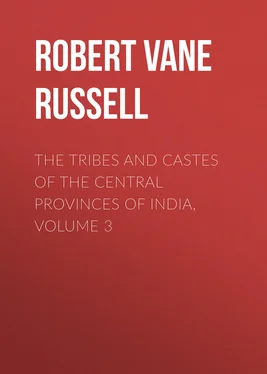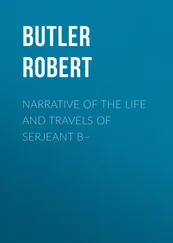Robert Vane Russell - The Tribes and Castes of the Central Provinces of India, Volume 3
Здесь есть возможность читать онлайн «Robert Vane Russell - The Tribes and Castes of the Central Provinces of India, Volume 3» — ознакомительный отрывок электронной книги совершенно бесплатно, а после прочтения отрывка купить полную версию. В некоторых случаях можно слушать аудио, скачать через торрент в формате fb2 и присутствует краткое содержание. Жанр: foreign_prose, История, foreign_edu, foreign_antique, на английском языке. Описание произведения, (предисловие) а так же отзывы посетителей доступны на портале библиотеки ЛибКат.
- Название:The Tribes and Castes of the Central Provinces of India, Volume 3
- Автор:
- Жанр:
- Год:неизвестен
- ISBN:нет данных
- Рейтинг книги:5 / 5. Голосов: 1
-
Избранное:Добавить в избранное
- Отзывы:
-
Ваша оценка:
- 100
- 1
- 2
- 3
- 4
- 5
The Tribes and Castes of the Central Provinces of India, Volume 3: краткое содержание, описание и аннотация
Предлагаем к чтению аннотацию, описание, краткое содержание или предисловие (зависит от того, что написал сам автор книги «The Tribes and Castes of the Central Provinces of India, Volume 3»). Если вы не нашли необходимую информацию о книге — напишите в комментариях, мы постараемся отыскать её.
The Tribes and Castes of the Central Provinces of India, Volume 3 — читать онлайн ознакомительный отрывок
Ниже представлен текст книги, разбитый по страницам. Система сохранения места последней прочитанной страницы, позволяет с удобством читать онлайн бесплатно книгу «The Tribes and Castes of the Central Provinces of India, Volume 3», без необходимости каждый раз заново искать на чём Вы остановились. Поставьте закладку, и сможете в любой момент перейти на страницу, на которой закончили чтение.
Интервал:
Закладка:
Killing of Rāwan, the demon king of Ceylon, from whom the Gonds are supposed to be descended
52. Cannibalism
Mr. Wilson quotes 78 78 Indian Caste , i. p. 325.
an account, written by Lieutenant Prendergast in 1820, in which he states that he had discovered a tribe of Gonds who were cannibals, but ate only their own relations. The account was as follows: “In May 1820 I visited the hills of Amarkantak, and having heard that a particular tribe of Gonds who lived in the hills were cannibals, I made the most particular inquiries assisted by my clerk Mohan Singh, an intelligent and well-informed Kāyasth. We learned after much trouble that there was a tribe of Gonds who resided in the hills of Amarkantak and to the south-east in the Gondwāna country, who held very little intercourse with the villagers and never went among them except to barter or purchase provisions. This race live in detached parties and seldom have more than eight or ten huts in one place. They are cannibals in the real sense of the word, but never eat the flesh of any person not belonging to their own family or tribe; nor do they do this except on particular occasions. It is the custom of this singular people to cut the throat of any person of their family who is attacked by severe illness and who they think has no chance of recovering, when they collect the whole of their relations and friends, and feast upon the body. In like manner when a person arrives at a great age and becomes feeble and weak, the Halālkhor operates upon him, when the different members of the family assemble for the same purpose as above stated. In other respects this is a simple race of people, nor do they consider cutting the throats of their sick relations or aged parents any sin; but on the contrary an act acceptable to Kāli, a blessing to their relatives, and a mercy to their whole race.”
It may be noted that the account is based on hearsay only, and such stories are often circulated about savage races. But if correct, it would indicate probably only a ritual form of cannibalism. The idea of the Gonds in eating the bodies of their relatives would be to assimilate the lives of these as it were, and cause them to be reborn as children in their own families. Possibly they ate the bodies of their parents, as many races ate the bodies of animal gods, in order to obtain their divine virtues and qualities. No corroboration of this custom is known in respect of the Gonds, but Colonel Dalton records 79 79 See article Birhor.
a somewhat similar story of the small Birhor tribe who live in the Chota Nāgpur hills not far from Amarkantak, and it has been seen that the Bhunjias of Bilāspur eat small portions of the bodies of their dead relatives. 80 80 See article Bhunjia.
53. Festivals. The new crops
The original Gond festivals were associated with the first eating of the new crops and fruits. In Chait (March) a festival called Chaitrai is observed in Bastar. A pig or fowl with some liquor is offered to the village god, and the new urad and semi beans of the year’s crop are placed before him uncooked. The people dance and sing the whole night and begin eating the new pulse and beans. In Bhādon (August) is the Nawākhai or eating of the new rice. The old and new grain is mixed and offered raw to the ancestors, a goat is sacrificed, and they begin to eat the new crop of rice. Similarly when the mahua flowers, from which country spirit is made, first appear, they proceed to the forest and worship under a sāj tree.
Before sowing rice or millet they have a rite called Bījphūtni or breaking the seed. Some grain, fowls and a pig are collected from the villagers by subscription. The grain is offered to the god and then distributed to all the villagers, who sow it in their fields for luck.
54. The Holi festival
The Holi festival, which corresponds to the Carnival, being held in spring at the end of the Hindu year, is observed by Gonds as well as Hindus. In Bilāspur a Gond or Baiga, as representing the oldest residents, is always employed to light the Holi fire. Sometimes it is kindled in the ancient manner by the friction of two pieces of wood. In Mandla, at the Holi, the Gonds fetch a green branch of the semar or cotton tree and plant it in a little hole, in which they put also a pice (farthing) and an egg. They place fuel round and burn up the branch. Then next day they take out the egg and give it to a dog to eat and say that this will make the dog as swift as fire. They choose a dog whom they wish to train for hunting. They bring the ploughshare from the house and heat it red-hot in the Holi fire and take it back. They say that this wakes up the ploughshare, which has fallen asleep from rusting in the house, and makes it sharp for ploughing. Perhaps when rust appears on the metal they think this a sign of its being asleep. They plough for the first time on a Monday or Wednesday and drive three furrows when nobody is looking.
Woman about to be swung round the post called Meghnāth
55. The Meghnāth swinging rite
In the western Districts on one of the five days following the Holi the swinging rite is performed. For this they bring a straight teak or sāj tree from the forest, as long as can be obtained, and cut from a place where two trees are growing together. The Bhumka or village priest is shown in a dream where to cut the tree. It is set up in a hole seven feet deep, a quantity of salt being placed beneath it. The hole is coloured with geru or red ochre, and offerings of goats, sheep and chickens are made to it by people who have vowed them in sickness. A cross-bar is fixed on to the top of the pole in a socket and the Bhumka is tied to one end of the cross-bar. A rope is attached to the other end and the people take hold of this and drag the Bhumka round in the air five times. When this has been done the village proprietor gives him a present of a cocoanut, and head- and body-clothes. If the pole falls down it is considered that some great misfortune, such as an epidemic, will ensue. The pole and ritual are now called Meghnāth. Meghnāth is held to have been the son of Rāwan, the demon king of Ceylon, from whom the Gonds are supposed by the Hindus to be descended, as they are called Rāwanvansi, or of the race of Rāwan. After this they set up another pole, which is known as Jheri, and make it slippery with oil, butter and other things. A little bag containing Rs. 1–4 and also a seer (2 lbs.) of ghī or butter are tied to the top, and the men try to climb the pole and get these as a prize. The women assemble and beat the men with sticks as they are climbing to prevent them from doing so. If no man succeeds in climbing the pole and getting the reward, it is given to the women. This seems to be a parody of the first or Meghnāth rite, and both probably have some connection with the growth of the crops.
56. The Karma and other rites
During Bhādon (August), in the rains, the Gonds bring a branch of the kalmi or of the haldu tree from the forest and wrap it up in new cloth and keep it in their houses. They have a feast and the musicians play, and men and women dance round the branch singing songs, of which the theme is often sexual. The dance is called Karma and is the principal dance of the Gonds, and they repeat it at intervals all through the cold weather, considering it as their great amusement. A further notice of it is given in the section on social customs. The dance is apparently named after the tree, though it is not known whether the same tree is always selected. Many deciduous trees in India shed their leaves in the hot weather and renew them in the rains, so that this season is partly one of the renewal of vegetation as well as of the growth of crops.
Читать дальшеИнтервал:
Закладка:
Похожие книги на «The Tribes and Castes of the Central Provinces of India, Volume 3»
Представляем Вашему вниманию похожие книги на «The Tribes and Castes of the Central Provinces of India, Volume 3» списком для выбора. Мы отобрали схожую по названию и смыслу литературу в надежде предоставить читателям больше вариантов отыскать новые, интересные, ещё непрочитанные произведения.
Обсуждение, отзывы о книге «The Tribes and Castes of the Central Provinces of India, Volume 3» и просто собственные мнения читателей. Оставьте ваши комментарии, напишите, что Вы думаете о произведении, его смысле или главных героях. Укажите что конкретно понравилось, а что нет, и почему Вы так считаете.












